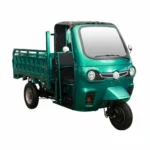With the rapid push toward sustainable mobility, electric vehicles are becoming a practical solution not only for personal transport but also for commercial use. One of the fastest-growing segments in this transformation is the Electric Loading Auto. These vehicles are designed specifically for carrying goods, reducing fuel costs, and lowering emissions while offering excellent efficiency for small and medium businesses.
In India, where short-distance cargo transport is vital for industries, shops, and delivery services, the Electric Loading Auto has emerged as a game-changer. From urban delivery hubs to rural areas, these eco-friendly autos are reshaping the logistics industry.
What is an Electric Loading Auto?
An Electric Loading Auto is a three-wheeler powered by an electric battery, designed to carry cargo loads ranging from 300 kg to 1000 kg, depending on the model. Unlike traditional diesel or CNG autos, electric loading autos operate with zero tailpipe emissions and run on rechargeable batteries.
They are commonly used by:
Small businesses for goods transportation
E-commerce companies for last-mile delivery
Farmers for carrying agricultural produce
Retailers and shopkeepers for stock movement
Benefits of Electric Loading Auto
1. Eco-Friendly Transport
Electric loading autos produce zero emissions, helping reduce air pollution in congested cities. With India aiming for a greener future, adopting EVs in the cargo sector is crucial.
2. Cost Savings
Running costs of electric autos are significantly lower than fuel-based vehicles. Charging costs per km are around one-third compared to diesel or petrol autos.
3. Government Incentives
The Indian government supports EV adoption through subsidies, tax exemptions, and reduced registration fees. These benefits make electric loading autos more affordable.
4. Low Maintenance
Since electric autos have fewer moving parts than internal combustion engines, they require less servicing. This lowers long-term maintenance costs for owners.
5. Suitable for Urban and Rural Areas
Compact size and strong loading capacity make them versatile for both crowded city roads and semi-urban or rural routes.
Key Features of Electric Loading Auto
Payload Capacity: Varies between 300–1000 kg depending on model
Battery Type: Lead-acid or lithium-ion batteries
Range per Charge: Typically 80–150 km
Charging Time: 3–6 hours (fast charging available in some models)
Top Speed: 25–45 km/h (ideal for city logistics)
Durability: Sturdy design for heavy load transport
Market Growth of Electric Loading Auto in India
The demand for last-mile delivery has grown exponentially due to e-commerce, food delivery apps, and online grocery platforms. Companies like Citylifeev are increasingly adopting electric loading autos for sustainable delivery operations.
Moreover, state governments are also pushing for EV adoption in public and private fleets. With rising fuel costs, many small business owners are switching to electric cargo three-wheelers to save money and increase profitability.
According to industry reports, India’s electric three-wheeler market is expected to grow at a double-digit CAGR, with E Loader forming a major part of this expansion.
Challenges of Electric Loading Auto
While electric loading autos are promising, a few challenges still exist:
Charging Infrastructure: Limited fast-charging stations in rural areas
Battery Replacement Costs: Lithium-ion batteries are durable but expensive to replace
Initial Purchase Price: Slightly higher than conventional autos (though government subsidies help)
However, with improving technology and government support, these challenges are gradually being resolved.
Future of Electric Loading Auto in India
The loader auto rickshaw sector is set to grow rapidly as India moves toward an EV-driven economy. With improved battery technologies, faster charging solutions, and strong government policies, these vehicles will soon dominate urban and rural cargo transport.
Businesses adopting electric autos not only save money but also contribute to building a cleaner and greener India.
Conclusion
The auto rickshaw dealership is not just a vehicle—it’s a revolution in India’s logistics and transport sector. Affordable, eco-friendly, and efficient, it empowers small businesses, boosts delivery services, and reduces dependency on fossil fuels. As infrastructure develops and awareness grows, electric loading autos will become the backbone of sustainable cargo transport in India.
Frequently Asked Questions (FAQ)
1. What is the average price of an electric loading auto in India?
The price typically ranges between ₹1.5 lakh to ₹3.5 lakh, depending on the brand, battery type, and load capacity.
2. How much load can an electric loading auto carry?
Most electric loading autos can carry between 300 kg to 1000 kg of goods.
3. How long does it take to charge an electric loading auto?
Charging time is usually 3–6 hours, but fast-charging models can recharge in about 2 hours.
4. What is the running cost per kilometer?
On average, the running cost is around ₹0.80 to ₹1.20 per km, which is much lower than petrol or diesel autos.
5. Are there government subsidies available for electric loading autos?
Yes, under the FAME-II scheme and state-level EV policies, subsidies and tax benefits are available, reducing the overall purchase price.
6. What type of battery is best for electric loading autos?
Lithium-ion batteries are preferred due to their long life, faster charging, and higher efficiency compared to lead-acid batteries.
7. Can electric loading autos be used in rural areas?
Yes, they are suitable for both urban and rural use, provided charging facilities are available.
8. How long does an electric loading auto battery last?
A lithium-ion battery usually lasts 3–5 years depending on usage and charging habits.

